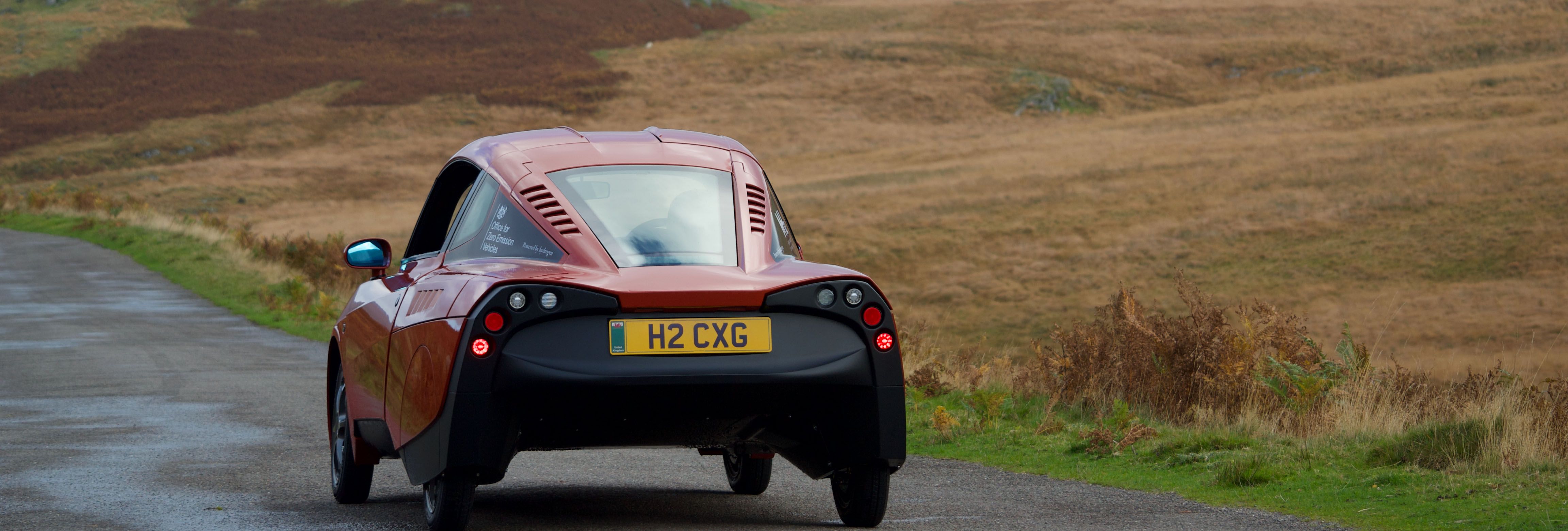Riversimple - sustainable mobility as a business model
Automotive & Mobility

The problem with our cars
With around 18% of global CO2 emissions, road traffic is one of the biggest climate sinners.¹ In addition to high CO2 emissions, individual automobile traffic has considerable structural waste in three areas: Utilization, energy efficiency and material use. Current research on usage behavior shows that the average car in Europe is used for less than 5% of its lifetime with only 1.5 out of 5 available seats.²
Although often advertised otherwise, cars, especially combustion engines, are anything but energy efficient. Tank-to-wheel energy consumption considers the chain of effects from the energy consumed (e.g. fuel) to its conversion into kinetic energy. In combustion engines alone, around 86% of the energy is lost through engine losses and idling. Further energy losses, such as transmission losses, mean that only 1% of a car's energy is actually used to transport people.³
Another planetary problem in the automotive industry is material waste. Although pressure on manufacturers at EU level is increasing and initial efforts are moving in the right direction, the current proportion of recycled plastics in cars is only 5.5%. Masses of materials are also wasted at the end of a car's life. According to the Empa research institute, less than 20% of plastic fractions recovered from end-of-life vehicles are currently recycled when they are scrapped. Critical earths or palladium are often not recovered at all.⁴
Even if car-sharing providers increasingly rely on electric cars and thus tackle the usage and energy problems, the immense material and resource problem remains. These cars are also sold after approx. 3 years of use and are usually scrapped a few years later.⁵
Mobility-as-a-Service as a solution
The British company Riversimple offers a circular alternative to many of these problems with its Mobility as a Service (MaaS). Cars can be subscribed to or rented for a certain period of time, while Riversimple takes responsibility for the entire life of the car, including maintenance, insurance and tire changes. Riversimple cars are specifically designed for a long useful life, which makes it easy to replace consumable parts and significantly extends the useful life of the cars.
As they are hydrogen fuel cell cars, Riversimple cars produce very low emissions while being highly energy efficient. The only product that results from the chemical reaction of hydrogen with oxygen to generate electricity is water.
Riversimple relies on the aerodynamic small car model Rasa. The body is not made of metal, as is often the case, but of carbon fiber, which makes the vehicle lighter and more energy-efficient. Similar to electric cars, the recovery of braking energy also helps to save energy. Some parts of the car, such as door handles or the upholstery material, are also made from recycled materials, further underlining Riversimple's vision of a circular business model. All these different advantages ensure that Rasa is one of the most efficient vehicles in its category.
Riversimple's understanding of holistic sustainability is also special. In addition to ecological aspects, social variables also play a major role, which can be illustrated through active interaction with the value chain. For example, the company is equally responsible to six voting custodian banks, representing the six stakeholder groups (customers, investors, environment, society, employees and business partners).
Of course, there are still major challenges to keep in mind here too. In order to have a positive impact on the climate, green hydrogen should predominantly be used. However, hydrogen is currently mainly produced from natural gas and is therefore not a renewable energy source.⁶ On the other hand, hydrogen as an energy carrier has a disadvantageous energy efficiency. While primary energy carriers such as natural gas or renewable energies are direct energy sources, hydrogen as a secondary energy carrier is produced through the conversion of primary energy. In order to transport or store the hydrogen obtained, it must in turn be bound with carbon dioxide or nitrogen. The problem here is that massive amounts of energy are lost with each such conversion process and energy efficiency is further reduced.
Nevertheless, it should be noted that Riversimple has created more than just a circular business model with its emission-reduced alternative to the fuel engine and its MaaS approach. With its system-integrator approach of involving everyone in the value chain, it is setting new standards in social sustainability for the automotive industry. It is therefore clear to us that Riversimple's ecosystem achieves the highest level of impact at Impact Level 3.
¹CO2 Emissionen weltweit » SFC Energy AG: in: SFC Energy, o.D., [online]
² Bilharz, Michael: Fahrgemeinschaften, in: Umweltbundesamt, o.D., [online]
³ McKinsey Center for Business and Environment/Ellen MacArthur/Klaus Zumwinkel/Martin R. Stuchtey/Frans Van Houten: Growth Within: A Circular Economy Vision for a Competitive Europe, in: Growth Within: A Circular Economy Vision for a Competitive Europe, o.D., [online]
⁴ Leistritz, Claudia: Autorecycling: EU-Kommission legt neue Richtlinie vor, in: PROFI Werkstatt, 24.07.2023.,[online]
⁵ Schmitt, Heidi: Wie umweltfreundlich ist Carsharing?, in: ReCYClist Magazin, o.D.,[online]
⁶ Statista: Produktion und Verwendung von Wasserstoff weltweit, in: Statista, 02.01.2024,[online]
Bdew: Flexible Herstellung: Wie wird Wasserstoff erzeugt?, in: BDEW, 26.01.2021, [online]
Photo © Riversimple
THANKS for your interest!
Are you curious and would like to know more? I would be happy to contact you to arrange an appointment to get to know each other.
